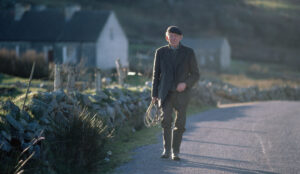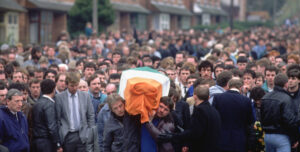Bernard Canavan has spent decades searching for information about his life before he was adopted in 1948, when he was nearly four years old, from St Patrick’s Guild in Dublin. When I visited him at his home in Willesden, the artist showed me a huge ring-binder filled with documents: copies of birth and baptismal certificates, letters from his parents promising to find the money to pay for his keep, correspondence with religious charities, newspaper clippings, photographs, and scores of printed-out emails.
It reminded me of the box of documents that sits on the table in an inner room of Lorna Brady’s house in the TV series, The Woman in the Wall. Lorna’s box contains newspaper articles about the mother and baby homes scandals, polite denials from officials she has begged for information, and a whole series of birthday cards she has written year after year — and never been able to send — to the daughter who was taken from her when she gave birth, in the mid-Eighties, in an institution run by nuns in the fictional village of Kilkinure, County Mayo.
The real-life Bernard Canavan searching for his mother and the fictional character Lorna Brady (played by Ruth Wilson), searching for her daughter, are two sides of one bleak story — about institutional power, and a society inured to the sacrifice of women and children to religious dogma. It’s a story that the Irish public is still struggling to come to terms with.
It was Peter Mullan’s 2002 film The Magdalene Sisters that brought Ireland’s female carceral regime to an international audience. The drama followed the young women and girls sent to the infamous Magdalene Laundries in the Sixties because they had been raped, or because they had boyfriends, or because they had fallen pregnant outside marriage, or — very often — because they were the children of single mothers. Because, in short, the church deemed them “fallen”. The last of these institutions only closed in the Nineties.
Then, in 2013, came Philomena, based on Martin Sixsmith’s best-selling book, The Lost Child of Philomena Lee. The child in question was like Bernard Canavan: adopted from a Mother and Baby Home at age three, against his mother’s wishes — though in this case he was adopted to the United States, and he never saw her again.
These stories had long been the subject of public debate in Ireland. In the mid-Nineties, journalist Mary Raftery’s exposé of the treatment of children in orphanages and reformatories, States of Fear, caused a national scandal. There have been multiple autobiographical accounts of the cruelty meted out to the incarcerated women and children, and a number of campaigns for justice and reparation. A series of Irish government commissions have investigated state involvement with the Magdalene laundries and child abuse in state-run children’s homes. In 2014, the bodies of nearly 800 babies and small children were discovered in a septic tank on the grounds of a former mother and baby home in Tuam, County Galway; the scandal was met with promises from the government to make amends. And in the past few years, best-selling novels by Sebastian Barry, Roddy Doyle, and Claire Keegan have all explored the legacies of this inhuman system.
The Woman in the Wall is the latest take in a long line, then. And, like other attempts, it has come in for some criticism. The use of both gothic horror and police procedural in Joe Murtagh’s telling has been deemed inappropriate. There are certainly sensationalist elements: a woman gets plastered inside a wall, there’s a haunted house with poisonous weeds and otherworldly screaming, a flock of crows lead to a dead body in an attic. Lorna’s home is poorly lit, with an ethereal red glow — especially the room containing the box of documents. And she’s suffering the kind of post-traumatic stress that leads her to sleepwalk and attack people and things while unconscious of her actions. But the viewer’s sense of dread seems appropriate to me. The horror genre becomes a form of realism when capturing the trauma of these institutions’ survivors, who are not living in a world where rational choice will save them. Something else is needed.
Murtagh makes this clear by flooding the daylight scenes with media debates about the violence of the history and the claims of survivors. There are radio call-in shows, meetings with politicians, conference halls and reports of discussions in parliament about the Laundries and mother and baby homes. There’s even a scene in which a group of women debate whether or not to sign compensation forms. In this Ireland, nothing seems to be hidden. The nation has turned its back on the cruelties of the past, and no one, apart from a few ancient nuns with a shaky grip on reality, is trying to defend the defunct institutional regime. Still, this is a detective drama — there are elements of the 2015 sexual abuse cover-up film Spotlight — and the viewer naturally asks, what more is to be discovered?
Several things, it turns out. First, that despite all the media coverage the ordinary inhabitants of Kilkinure still don’t think all that historical unpleasantness has much to do with them. They have a lot to learn. We watch the slow realisation of the local policeman — a sympathetic, at times comic character — that he was part of the system that kept young girls imprisoned against their will. The implication is that the whole town colluded in choosing not to acknowledge what they knew was going on in the Convent. There’s knowing and there’s knowing, says the sergeant.
The series would have us believe that, in addition to incarcerating young women and girls, and forcing them to do unpaid labour, the homes offered up their children for illegal adoption, in exchange for money. The claim that mother and baby homes colluded with Irish adoption societies to sell children, often to the United States, was not substantiated by the Report of the Commission on Mother and Baby Homes. But that doesn’t mean it didn’t happen. In 2021, a group of ten adoptees sued St Patrick’s Guild — from where Bernard Canavan was informally adopted in 1948 — for facilitating illegal adoptions. The home was accused of “kidnapping, forgery…and conspiracy for wrongful concealment”, in the course of a series of “well-practised and systematically perfected child abductions”. At least 126 illegal adoptions between 1946 and 1969 have been verified and there are estimates that the true number could reach 15,000.
And beyond the scandal at St Patrick’s there is plenty of anecdotal evidence that babies were sent to the United States from homes across the country in exchange for donations in the Forties and Fifties. But Murtagh’s drama goes further, depicting a shady extreme-religious outfit that is involved in stealing babies from mothers against their will, and selling them to fund their organisation, right up until the Eighties. It’s a system that echoes the Franco-era Stolen Babies scandal, currently being investigated by Amnesty International, in which thousands of babies were taken from their mothers and given to families supportive of the regime.
The claim that a similar system operated in Ireland, and maybe still operates, seems so outlandish that it nearly topples the fictional world Murtagh has built. But when the guards uncover a link between the Irish baby-selling business and the bombing of an abortion clinic in the US, the viewer is reminded of today’s network of extreme Right-wing religious groups, powered by an absolute sense of the rightness of their moral mission even to the point of committing murder. In a bold move by Murtagh, the Irish version of these ideologically-driven conservative family warriors masquerades as a harmless lobbying group, that sits right at the heart of the political establishment.
When The Magdalene Sisters was screened in 2002, the focus of the scandal was on the cruelty of the nuns and priests in overall charge of the institutions, and the secrecy with which they operated; in Philomena it was on the terrible legacy of a mother losing a child and a child losing his mother. Now that the Irish media is awash with public debate about this history, and has grown used to government commissions, state apologies, and reparation scheme, the focus of the story has shifted – to the way that all those words of regret and sorrow may be just another way of covering up what really happened.
Survivors of institutional abuse still find themselves struggling to be taken seriously — having to argue through the courts for the right to access their own records, for example, or for their own evidence of their experience to be accorded the same weight as that contained in institutional records. In 2021, Philomena Lee was one of several high court challengers to the claim in the final report of the 2020 Commission of Investigation into Mother and Baby Homes that there was “no evidence” to suggest her consent to her son’s adoption was not full, free and informed. She was given no time to consider a document that she was told to sign, which relinquished her rights to her son.
The backdrop of the latest versions of the story is the disturbing possibility of a coming backlash against the women and children who suffered. After all, in the United States Amy Coney Barrett has argued against abortion provision on the grounds that women should be required to give birth in order to give their children up for adoption to families that want them.
In the face of this bleak future, these empty apologies, victims of institutional abuse have little to hang on to, besides the ring-binders and cardboard boxes which hold evidence of experiences that they know to be true.
Disclaimer
Some of the posts we share are controversial and we do not necessarily agree with them in the whole extend. Sometimes we agree with the content or part of it but we do not agree with the narration or language. Nevertheless we find them somehow interesting, valuable and/or informative or we share them, because we strongly believe in freedom of speech, free press and journalism. We strongly encourage you to have a critical approach to all the content, do your own research and analysis to build your own opinion.
We would be glad to have your feedback.
Source: UnHerd Read the original article here: https://unherd.com/



